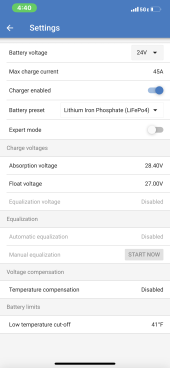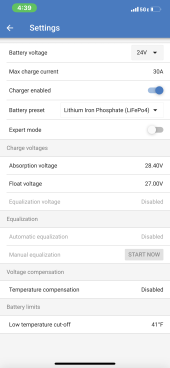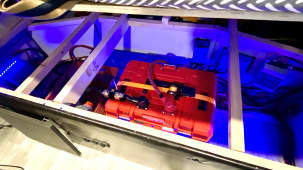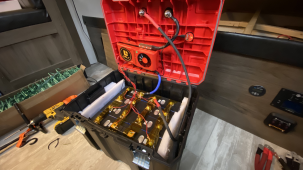Off Gridin' It
New Member
- Joined
- Dec 11, 2020
- Messages
- 102
Here are some details of my system.
I have two SmartSolar charge controllers feeding one DIY battery.
Charge controller 1
SmartSolar 150/45 - Fed by a 1200 watt array on the roof of the camper.
Charge controller 2
SmartSolar 100/30 - Fed by a 500 watt ground deploy array
Battery Bank
6014 wh DIY battery - 24 volts
8S - Daly 250 amp BMS
I am getting a "Cell volt high level 2" fault alarm on the daly BMS.
The BMS turns off charging when this happens but otherwise is operating normally and once the charging backs off due to a load being put on the battery the fault clears and charging resumes.
The BMS cell voltage limit is set to 3.65 and the "Sum volt high protect" is set to 29.2.d
So it would seem the charge voltage from the Smart Solar charge controllers is exceeding the limit.
When only one charge controller is connected this doesn't happen.
But if I have used a lot of power overnight for some reason and I deploy the ground array to charge faster then once it reaches absorption I get the "Cel volt hight level 2" Fault.
((((MY QUESTION))))
My question is can I tell one of the SmartSolar charge controller to stop charging at 99% so that it won't exceed the voltage limit? Should I set the float voltage lower? It is set to 27.00 volts now.
Or should I set the absorption voltage lower? It is set to 28.4.
@Guy Stewart (Victron Community Manager)
I have two SmartSolar charge controllers feeding one DIY battery.
Charge controller 1
SmartSolar 150/45 - Fed by a 1200 watt array on the roof of the camper.
Charge controller 2
SmartSolar 100/30 - Fed by a 500 watt ground deploy array
Battery Bank
6014 wh DIY battery - 24 volts
8S - Daly 250 amp BMS
I am getting a "Cell volt high level 2" fault alarm on the daly BMS.
The BMS turns off charging when this happens but otherwise is operating normally and once the charging backs off due to a load being put on the battery the fault clears and charging resumes.
The BMS cell voltage limit is set to 3.65 and the "Sum volt high protect" is set to 29.2.d
So it would seem the charge voltage from the Smart Solar charge controllers is exceeding the limit.
When only one charge controller is connected this doesn't happen.
But if I have used a lot of power overnight for some reason and I deploy the ground array to charge faster then once it reaches absorption I get the "Cel volt hight level 2" Fault.
((((MY QUESTION))))
My question is can I tell one of the SmartSolar charge controller to stop charging at 99% so that it won't exceed the voltage limit? Should I set the float voltage lower? It is set to 27.00 volts now.
Or should I set the absorption voltage lower? It is set to 28.4.
@Guy Stewart (Victron Community Manager)







